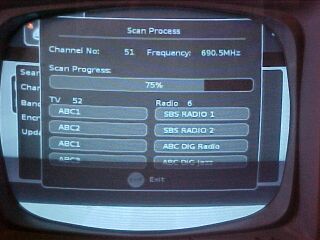
The DVX555 doing the channel scan at setup. Set is a 1957 Kriesler 79-1 chassis, Model 121-1.
The demand for digital TV was never consumer
driven. Australia is fortunate in using the best TV system in the world.
625 lines and chroma phase error immunity with the PAL system gives us
a considerable advantage over countries stuck with NTSC. In fact, with
a good aerial, the digital picture is no better than its analog equivalent.
So why did big business push the government to implement it?
The media organisations were quite happy
with the original setup; that is, three commercial and two national channels
Australia wide. However, six channels of digital can be put in the same
bandwidth of one analog channel. Thus each parent channel was required
to implement a number of digital channels. For example, Channel 7 created
72 and 7mate. One of these three channels was also required to be so called
high definition (1080 lines). A problem with too many channels is there's
only a finite amount of television programming that can be made. The result
of this has been that for the commercial channels, their secondary channels
are largely repeats or very cheap U.S. programs. Channels for purely shopping
are also wasting the bandwidth. Fortunately, SBS and the ABC have made
good use of their secondary channels in comparison.
One reason for the replacement of the
analog system came from electronics manufacturers. By insisting the existing
analog transmissions are turned off, even though there is no need to do
so, it's a great way to force everyone to buy new TV sets or digital boxes!
All that income for the greedy manufacturers. In reality, people have to
buy things they don't and didn't need, and China uses up the world's resources
making all this new stuff, furthering environmental damage.
A main driving force to kill off the analog
TV was from phone companies. Put simply, they wanted to the top end of
the UHF band for yet more mobile phones. That's right - so more zombies
walk around attached to phones, unable to function in society without them,
we kill off a perfectly good TV system. The government sold the upper UHF
channels for several billion dollars. How's that for an easy profit?
One weak excuse given by the government
was that program production is now done digitally. True that is, but has
absolutely nothing to do with how the signal is transmitted.
However, there is one useful feature of
digital TV. In areas where even the best aerial won't get rid of the ghosts,
digital TV will. (At this point I need to mention that anti ghost systems
were developed for analog TV during the 1970's & 80's but consumers
weren't interested). Having installed TV aerials and serviced TV sets over
the years, one thing I learned is a lot of people are happy with poor picture
quality, and become very tight about paying for a decent aerial installation.
"Can't you do it any cheaper than that?", just after they've happily spent
$2000 on a new television.
In areas where the signal is not strong
enough to provide a snow free picture, the digital system will...but up
to
a point. Below a certain signal level, the digital signal is lost, leaving
the viewer with nothing, or a blocky jumpy picture at best, with defective
sound. An analog picture would still exist at this level.
Conventional signal strength meters do
not work with digital signals as they resemble a 7MHz block of noise. A
spectrum analyser is the only practical way to see what's going on with
the aerial system.
Ideally, both systems should exist together.
The digital system can be appreciated by those in areas with bad ghosting,
or who think that anything "digital" is superior. Retaining the analog
system would allow for the continuation of low cost TV set production and
for reception in weak signal areas.
The Shutdown of Analog
Television.
At 9.00am, 3rd December, 2013, all the
transmitters in Sydney were turned off. I recorded the event both optically
(a camera pointed at five TV sets), and on videotape. With seconds of each
other, all the signals were gone. While I had of course been using digital
boxes for the secondary channels, I had viewed the primary channels on
analog right until the end. Faster channel changing, and not having to
use a box were the reasons for this.
The only concession to this sad event
was that at least 625 line analog signals could still be had off air via
digital boxes, and that existing aerials were still useable. Contrast this
to the situation in the UK in the early 1980's when the 405 line system
was turned off. There were no cheap boxes for standards conversion, and
there was no more VHF transmission. It meant the end of viewing 405 lines,
except for old videotapes, cameras, or pattern generators. Unless you were
one of the few who acquired a standards converter when the transmitters
were turned off, or made your own primitive optical converter, you had
no live programming to watch.
These days there are small electronic
standards converters for 405 lines, but they are expensive and I
understand supply is erratic as the units are produced in low quantities.
Dealing with the situation
practically.
It had been surprising that for some time,
an often asked question was "what are you going to do when they turn the
signals off?", in reference to my vintage TV sets. I would have thought
the obvious answer was to use a digital box, but I guess some people thought
that an 1956 set was somehow "too old" or "too something" to use.
There is no need for alarm. A television made in 1956 works on the same
625 line 50 field negative modulation, 5.5MHz FM sound signals as the last
analog sets. The only difference is that in 1974 the chroma subcarrier
was switched on at the TV stations (colour had been transmitted experimentally
since the late 1960's but as the government didn't want people importing
colour sets to view these transmissions, the colour subcarrier was removed
prior to transmission).
So, just like with a modern colour set,
the method of using your antique for digital is the same. Digital boxes
are now available for around $20-$30.
An interesting feature of some boxes is
that you can select NTSC output in the setup menu. This means that you
can effectively use an American colour TV set to watch the Australian digital
TV channels, in colour, without any modifications. Programs can also be
recorded on an NTSC VCR or fed into an NTSC only video capture card etc.
If you like collecting foreign TV sets this is a very useful feature. I
discuss it further here.

The DVX555 doing the channel scan at setup. Set is
a 1957 Kriesler 79-1 chassis, Model 121-1.
However a digital box is not always the
complete answer. Most of these boxes have only baseband audio and video
out, and a few have UHF output. Not very useful on a VHF TV with no AV
inputs. What to do? Where the box has only AV outputs:
1) Feed the baseband inputs into a VCR
that outputs on a VHF channel. Of course, the VCR will also be able to
record the digital programs.
2)Get a VHF modulator and feed the box
into that. Modulators can be bought new as a stand alone box with AV sockets
and built in power supply, or
removed from dead VCR's,
some first generation home computers or TV games. Note that some TV game
or computer modulators do not provide sound.
Where the box also has UHF output (e.g.,
some of the Bush models), you can:
1)Feed the UHF into a VCR that outputs
on a VHF channel.
2)Use a UHF to VHF converter. To keep
with the period theme, you can get valve UHF converters off the US eBay.
The U.S. channel 6 is close enough
to Australian channel 3 for
this application.
A
word on VHF channels:
It is important to know that the VHF channels
of 1956 are not the same as the VHF channels of now and this affects sets
made before 1961. Despite plans being drawn up for Australia-wide TV using
the original 10 channels, in 1961 the number of channels was increased
from 10 to 13. Comparing the pre and post 1961 channel plans, there's actually
not much difference in areas served. In fact, in the earlier plan there
were allowances for separate TV stations in the Blue Mountains and Bathurst,
among other places. Increasing the amount of channels was also an
ideal excuse to kill off FM broadcasting - considered by the AM broadcasters
as a threat.
Briefly, the old channels 1,4, and 5 were
changed in frequency, and new channels 0, 5A, and 11 were added. For commercial
interests, the existing channels operating at the time 2,7,9 in the mainland
capitals, and 2 and 6 in Hobart, did not have their channel number or frequency
changed. This is why we have channel O and 5A, and the numbers are not
simply 1 to 13.
The channels that did not change are:
2,3,6,7,8,9,10 (10 did but only by 1Mc/s which is insignificant and well
within the range of the fine tuning control).
Due to amateur radio operators complaining
about our unique channel frequencies being next to an amateur band (Ch
0 & 5A ), and others complaining about TV channels in the FM band (Ch
3,4,5),pressure was to move many of the stations broadcasting on these
politically incorrect channels to UHF. This began in the 1980's.
At least digital TV didn't kill off VHF,
but it will only ever be broadcast in Band 3. The excuse for not having
it in Band 1 is that electrical interference will cause unreliable reception.
The hypocrisy is exposed! Not so rugged is it now!! And, the pro FM crowd
have seen to no more new TV transmitters in Band 2 long ago. However, it
is now unlikely that any new FM stations will be established due to the
inception of digital radio.
As Australian VCR's with VHF output transmit
on either 0/1 or 3/4, you need a 3/4 model for a pre 1961 TV set. The UHF
converters once sold by Tandy also output on 3 or 4.
You can use a 0/1 model if you wish...
The old channel 1 is about 4Mc/s higher
than channel 0, so providing there's enough adjustment in the local oscillator
you can tune down to channel 0. You should really retune the RF circuit
but in practice just the local oscillator is enough in most cases. Sets
used in Brisbane and Melbourne are likely to have been modified for channel
0, as broadcasting started in these cities while ten channel sets were
being produced.
I had used ten channel sets since the
days of SBS being on channel 0 in Sydney and had good results.
You can also tune up to the present channel
1, but this usually requires a greater range of adjustment.
With my Ekco
TX287 I had to add a few pF across the oscillator coil in the tuner
to get its channel 1 down to channel 0. Why didn't I use channel 3? Because
this biscuit was not fitted in the tuner.
Turret tuners are a lot easier to adjust
in this regard than the incremental kind. As the tuned circuits in incremental
tuners use what is essentially a switch selecting a coil tapping, doing
anything to one channel affects all the others. The adjustments are fairly
interactive. With turret tuners, all the coils are totally isolated from
each other so you can totally stuff one channel up without affecting the
others.
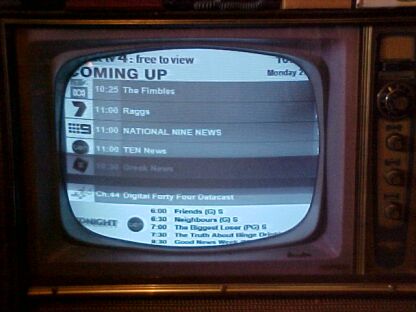
One handy feature is the program guide (this can be
done with the analog system as per Teletext)
The other option of course is to simply provide AV inputs on your TV. I'm not recommending this as it means butchering the set. The audio level from a digital box is compatible with the typical triode pentode audio stage and can be fed into the set's volume control via a capacitor (something like .1uF). The unterminated video output of the box is 2Vp-p which will drive a video output pentode. It should not be terminated in 75 ohms, contrary to correct procedure, as this will reduce the level by half and perhaps provide insufficient contrast. In practice with short leads the correct termination isn't important. A potential problem is with sets that have their contrast control as part of the AGC system; this will not work properly (or at all) with direct video input and would require modifications. Of course, for live chassis sets, it is unsafe to provide AV inputs..
Aerials
Don't automatically
be conned into needing a "digital" aerial or "digital" whatever. The digital
transmissions are in the same VHF and UHF bands used by the existing channels;
it's only the modulation that has changed. Where a new aerial is required
is where the digital channels are in a different band to what the existing
aerial is capable of receiving. The new aerial certainly doesn't need to
be a "digital" type; it just needs to merely operate in the required band.
In fact, many of the Hills and Matchmaster "digital ready" aerials are
simply old models with an F socket attached instead of screw terminals.
I live about 80km
from Gore Hill and about 90km from Knight's Hill. There are two TV aerials
feeding my system. One is this fan
aerial which receives all the Gore Hill channels on VHF and UHF. A
91 element UHF aerial (based on the Fuba XC391) receives the Knight's Hill
channels, Prime, WIN, Capital, ABC, and SBS.
The Gore Hill aerial
is connected to my distribution system under the house by 300 ohm ribbon.
The Knight's Hill aerial, in view of the weak signal, required a masthead
amplifier, and thus has to be connected by coaxial cable. The Gore Hill
signals are amplified separately, and combined with those from Knight's
Hill, using a Johansson HL13F triplexer. The signal is then split six ways
to feed all the sets in the house. FM signals from the fan aerial are filtered
out and amplified separately. This eases the load on the TV distribution
amplifier - the more signals it has to amplify, the more chance of intermodulation
distortion.

Aerial for Gore Hill (Sydney) reception. This aerial
connects to the distribution system under the house via low loss 300 ohm
slotted ribbon. This aerial also provides FM radio reception.
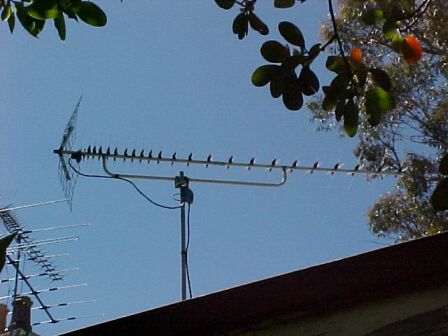
For Knight's Hill (Wollongong) reception, this 91
element UHF aerial is used. The masthead amp can be seen under the mounting
clamp. Previous aerials for Gore Hill reception are visible to the
left.
What really matters is that the aerial being used has a smooth frequency response over the required channels. Narrow band aerials, such as Yagis can be problematic here. Also, poor connections or low quality accessories used with the aerial can result in notches in the frequency response as shown below. These characteristics can give rise to intermittent digital reception. Log periodics or other wideband designs are a good choice.
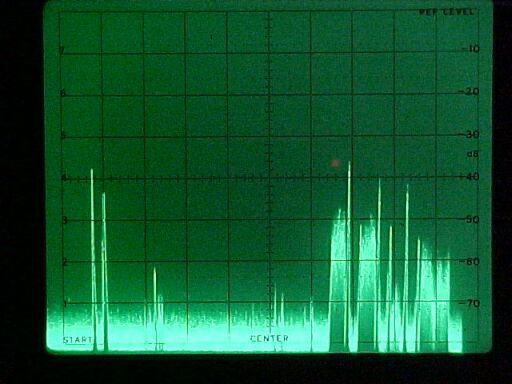
Spectrum of the VHF TV band as received with an old Channel Master
636 which is a dual band Yagi intended for Ch's 2 and 7-10. At the left
are the channel 2 vision and sound carriers. Further along are some FM
carriers, largely suppressed by a trap. The analog channel 7,9, and 10
carriers are to the right. What look like blocks of noise are the digital
channels. Channel 6 digital is immediately to the left of analog ch7, digital
ch8 to the left of analog ch9. Immediately to the right of the analog ch10
sound carrier are digital channels 11 & 12. It is because the digital
channels appear as noise to analog equipment, that a spectrum analyser
is required to measure the signal strength. The received channel 2 signal
is actually 12db stronger than shown here; it was necessary to install
a low band attenuator to prevent overload. This display shows the problem
which can occur with some older aerials in that the gain falls of above
Ch 10. Also, close observation shows a notch in the Ch 12 signal. This
was causing problems with ABC digital which uses this channel.
300
Ohm Ribbon for UHF and digital
Unfortunately, it
seems to be drummed into the heads of Australians that ribbon cable is
unsuitable for UHF, and the local catalogs that still show it usually advise
that it's for "VHF only". I wonder what millions of Americans would think
about that, having had UHF signals fed to their sets with ribbon since
the 1950's. A quick check of the online Channel Master catalog shows that
one of the world's most prominent TV aerial manufacturer still manufactures
300 ohm ribbon and gives instructions on how to connect ribbon cable to
their VHF/UHF aerials. Having once lived in an atrocious signal area, replacing
the supposed "essential for UHF" coaxial cable with ribbon not only brought
the UHF right out of the snow but allowed the use of a few splitters too.
Might as well put a paper clip across the aerial terminals if you're going
to use coax cable for unamplified UHF. And the supposed poor antighosting
characteristics of ribbon? What a lie that was. This area was not only
suffering from weak UHF but also very ghosty signals on all VHF and UHF
channels. So ghosty in fact, that only one aerial would eliminate the ghosts
(Channel Master 3112). Changing the coax to ribbon did not introduce any
ghosts. This area was only a couple of kilometres from the transmitters
and down in a valley where there was an abundance of reflected signals.
So, I've learnt a thing or two about weak and ghosty signal areas. The
whole point of 300 ohm line is that it's balanced. So, equal amounts of
signal being picked up by the line itself are cancelled out. The Australian
aerial manufacturers insistent on the use of coaxial cable, when confronted
about the high loss, will say to use a masthead amplifier. Indeed, that
will work, but compare the cost of the coax and a masthead amplifier with
just the required length of ribbon. Just a conspiracy to rake in the profits.
Of course the coaxial cable/amplifier approach is justified for some applications
(e.g. where there are too many splits for unamplified signal, or the signal
at the aerial terminals is too weak to be fed down even the best ribbon)
but for many residential installations it is unnecessary.
Interestingly, where
UHF signals are strong, some VHF aerials will work very well on UHF. The
Channel Master 3112 is one example. In fact, although irrelevant now, its
excellent anti ghosting characteristics worked just as well on UHF. The
Channel Master 1057 Challenger is another good UHF candidate. It provided
snow free Ch28 reception 80km from the transmitters. Having said that,
I wouldn't use such VHF aerials for UHF DX reception, and although I haven't
tried it, I would assume the Band 5 response would be much less than Band
4. Having done UHF DX work I can yet again support the use of 300
ohm ribbon. I can just imagine some readers of what I've just said being
quite horrified, but my question is, have you actually tried it? You only
have to look up the loss tables for coax vs. ribbon at UHF.
It is also claimed
that the coaxial cable must be quad shielded RG6 and F connectors must
be used. Again, I've found this to be untrue. The only real advantage in
using RG6 is lower loss on UHF where there is no amplification.
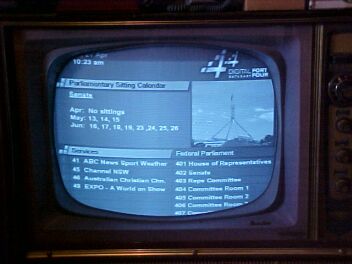
Digital Channel 44 (which has since closed after this
photo was taken). This has what are termed "narrowcasting" channels. Digital
TV wasn't even dreamed of when this set was made but as you can see it
performs perfectly with the new signals.
Living with digital
only TV.
While I certainly felt an emptiness with
the loss of the AM and FM television signals that have existed for all
my life, I actually don't dwell on that now. In practice, the idea of just
connecting an aerial straight to a TV and watching it is no more. One has
to drag out a digital box and modulator/VCR/ or UHF converter as well.
It means that when changing channels there is a delay until the box
loads up with the new data, before a picture appears. For the sets I regularly
watch, which are the same ones before the analog switch off, a digital
box is permanently set up with them, and apart from the channel change
delay, it isn't actually a problem. It does mean a separate box for the
VCR and TV where it's desired to record one channel and watch another.
Where multiple digital boxes are used together, it's important to use ones
that do not respond to each others remote controls - and quite a number
of them do.
What is a real problem is portable viewing.
Lugging around a digital box and aerial as well as the TV set itself limits
the practicality. While I do have a pocket digital TV set, a severe problem
is the digital signal in areas of fluctuating or weak signal strength.
For example, watching TV on a train would result in a snowy, but recognisable
picture along some parts of the journey. Now, you get nothing except in
very strong signal areas.
The real worry about digital only TV is
the boxes. They are, except for power supply faults and failed electrolytic
capacitors, impractical to repair. So far, the record of reliability does
not appear to be very good. I have a growing mound of faulty boxes. For
example, one Jaycar box no longer receives VHF. Fortunately, I can still
use it for the Knight's Hill channels. One of my DVX boxes developed sync
crushing on bright scenes as well as glitches when the hard disc operated.
Luckily, replacing all the electrolytic capacitors fixed it. Another had
a start up resistor in the power supply go high, etc.
What I can't fix is software problems,
and a number of boxes have succumbed to that - unable to complete the channel
scan, locking up, unable to change aspect ratio, and so on.
While the boxes are so cheap and readily
available now to replace faulty ones, the nightmare will be when they stop
producing them with 625 line composite video output.
